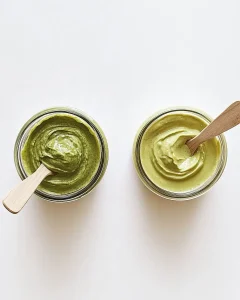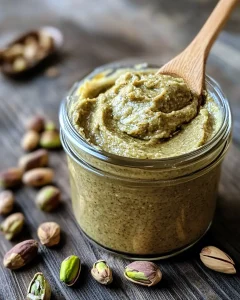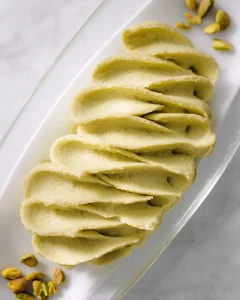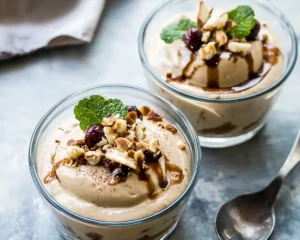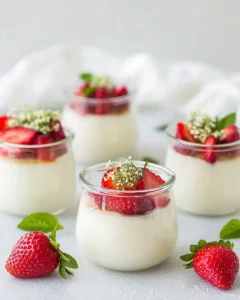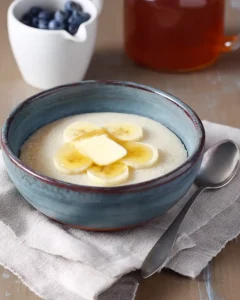Is Pistachio Butter the Same as Pistachio Cream
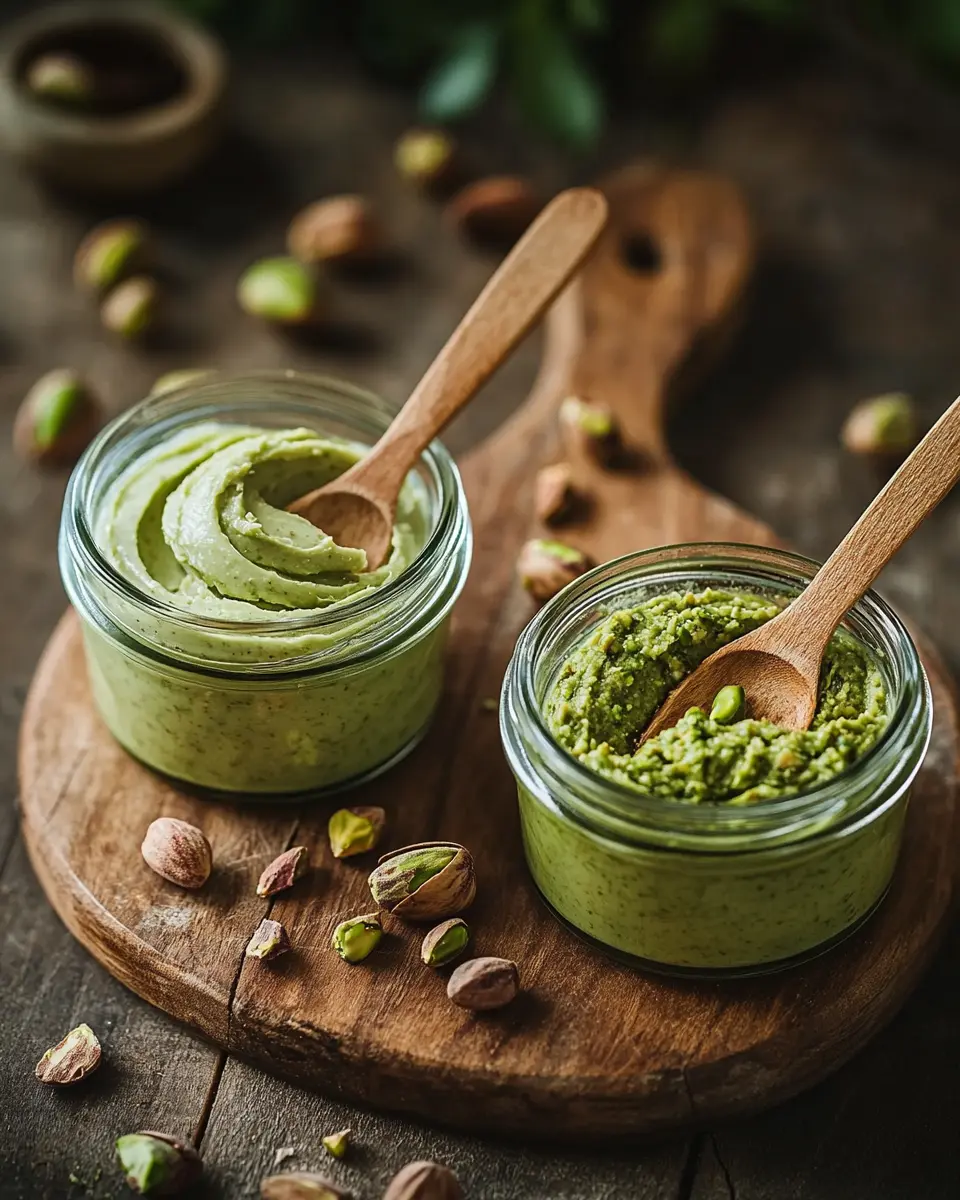
Is pistachio butter the same as pistachio cream? Discover key differences, uses, and which pistachio spread works best for your recipes.
Well hello there, fellow dessert adventurers! I’m Rebeccah, your spirited guide through the wonderfully nutty world of pistachio spreads. Picture this: there I was last Tuesday, standing in my kitchen with flour dusting my favorite apron, when my neighbor knocked on the door. She held up two jars—one labeled “pistachio butter” and another “pistachio cream”—with the most puzzled expression.
“Rebeccah,” she said, “are these the same thing? I grabbed both at the store because I honestly couldn’t tell!” That moment transported me right back to my grandmother’s cozy kitchen, where I first learned that baking isn’t just about following recipes. It’s about understanding your ingredients like old friends.
You see, my journey started with that little girl clutching an oversized wooden spoon, watching Grandma transform simple nuts into magical spreads. However, I’ll admit—I once ruined an entire batch of pistachio macarons because I used the wrong type of pistachio spread! That kitchen mishap taught me everything I know today about these gorgeous green treasures.
Now, after years of building Dessert Haven and countless experiments with pistachio spreads, I’m thrilled to share this ultimate guide with you. Together, we’ll unravel the mystery of pistachio butter versus pistachio cream, so you’ll never face that grocery store confusion again!
Table of Contents
Understanding Pistachio Spreads: The Essential Breakdown
What Makes Each Spread Unique?
Pistachio butter and pistachio cream might look similar at first glance, but they’re actually quite different products. Think of it this way: they’re like cousins in the same delicious family, yet each has its own personality and purpose.
Pistachio butter represents the pure, unadulterated essence of pistachios. Manufacturers create this spread by grinding roasted pistachios until they release their natural oils, forming a thick, rich paste. The process mirrors how we make almond butter or peanut butter—it’s essentially just nuts transformed into spreadable form.
Meanwhile, pistachio cream takes a more elaborate approach. This luxurious spread combines pistachios with additional ingredients like sugar, oils, milk solids, or even vanilla. The result? A smoother, sweeter, and often more versatile product that’s particularly popular in European desserts.
Now that we’ve established that pistachio butter and cream are distinct products, you might be wondering how they compare to other nut butters and spreads in terms of versatility, nutrition, and culinary applications. Our comprehensive Pistachio Cream vs Nut Butter analysis provides the complete picture, including professional insights on when to choose pistachio products over traditional alternatives like almond or peanut butter. This essential guide will help you make informed decisions for every recipe and dietary need.
Key Ingredient Comparison
| Pistachio Butter | Pistachio Cream |
|---|---|
| 100% roasted pistachios | Pistachios (60-80%) |
| Natural pistachio oils | Added oils (palm, sunflower) |
| No added sugars | Sugar or sweeteners |
| Minimal processing | Enhanced with milk solids |
| Grainy texture | Smooth, creamy texture |
Shopping Tips for US Grocery Stores: Most American supermarkets stock pistachio cream in the international aisle, particularly near Italian imports. You’ll find pistachio butter in the natural foods section alongside other nut butters. Whole Foods and Trader Joe’s typically carry both varieties year-round.
Quality Indicators: Look for pistachio butter with a deep green color—pale spreads often indicate over-processing or poor-quality nuts. For pistachio cream, check that pistachios appear first on the ingredient list. The best products will have that distinctive pistachio aroma when you open the jar.
The Manufacturing Process: How Each Spread Comes to Life
Pistachio Butter Production
Creating authentic pistachio butter requires patience and precision. First, producers carefully select premium pistachios, then roast them to enhance their natural flavors. The roasting process typically takes 10-15 minutes at moderate temperatures to avoid burning the delicate nuts.
Next comes the grinding phase. Industrial food processors crush the roasted pistachios for extended periods—sometimes up to 20 minutes—until the friction generates enough heat to release the natural oils. This process transforms the nuts from coarse pieces into that signature smooth, spreadable consistency.
The final product contains absolutely nothing except pistachios. No stabilizers, no added oils, no preservatives. Just pure, concentrated pistachio flavor in spreadable form.
Pistachio Cream Manufacturing
Pistachio cream follows a more complex production method. Manufacturers begin with similar high-quality pistachios but then blend them with carefully selected additional ingredients. Sugar adds sweetness, while various oils contribute to the ultra-smooth texture that makes pistachio cream so appealing.
Many premium versions include milk powder, which creates that luxurious mouthfeel we associate with European-style spreads. Some producers add natural vanilla or other complementary flavors to enhance the overall taste profile.
The mixing process involves specialized equipment that can achieve incredibly fine textures. This results in a product that spreads effortlessly and melts beautifully when used in baking applications.
Texture and Taste: The Sensory Experience
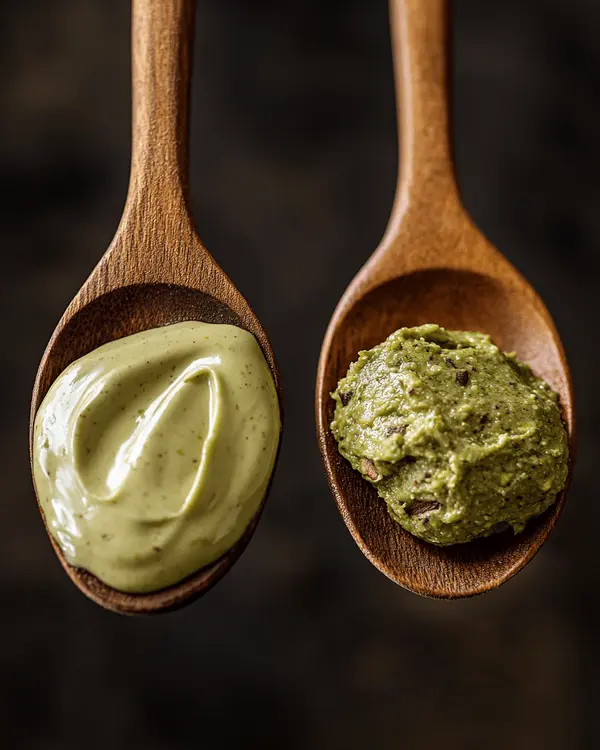
Pistachio Butter Characteristics
Pistachio butter delivers an intense, concentrated pistachio experience. The texture resembles natural peanut butter—thick, slightly grainy, and rich. When you taste it, the pure pistachio flavor hits immediately, followed by subtle nutty undertones and a slightly savory finish.
The consistency can vary depending on room temperature. Cold pistachio butter becomes quite firm and requires some effort to spread. Warm it slightly, and it transforms into a more pliable, almost liquid consistency that’s perfect for drizzling or mixing into recipes.
One thing I’ve learned from years of working with pistachio butter is that a little goes a long way. The flavor is so concentrated that just a tablespoon can transform an entire dessert.
Pistachio Cream Profile
Pistachio cream offers a completely different sensory journey. The texture is silky smooth, almost like premium frosting. It spreads effortlessly at room temperature and maintains its consistency across various temperatures.
Taste-wise, pistachio cream provides a mellower, sweeter pistachio experience. The added ingredients create a more balanced flavor profile that appeals to those who find pure pistachio butter too intense. It’s reminiscent of high-end gelato or fine European pastries.
The mouthfeel is particularly noteworthy—it melts on your tongue, releasing layers of flavor that include the pistachio base, subtle sweetness, and often hints of vanilla or other complementary notes.
Culinary Applications: When to Use Each Spread
Best Uses for Pistachio Butter
Pistachio butter shines in applications where you want pure, unadulterated pistachio flavor. I love using it in homemade pistachio butter cookies, where its intense flavor can stand up to other strong ingredients like dark chocolate or espresso.
Baking enthusiasts will appreciate how pistachio butter behaves in recipes. Its natural oils help create moist textures in cakes and muffins. Additionally, it works beautifully in no-bake energy balls or protein bars, providing both flavor and binding properties.
For breakfast applications, try swirling pistachio butter into oatmeal or yogurt. The rich, nutty flavor pairs wonderfully with fresh berries or a drizzle of honey. You can also thin it with a little warm milk to create a unique hot beverage.
Best Uses for Pistachio Cream
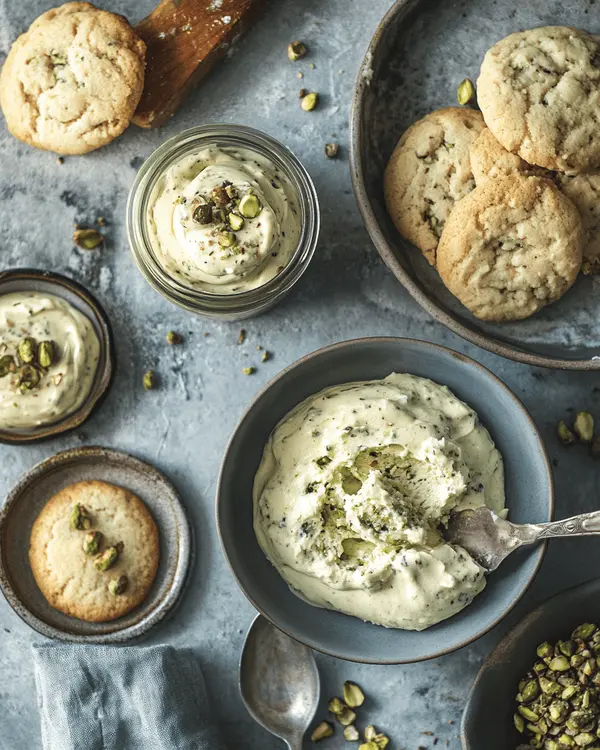
Pistachio cream excels in dessert applications where smoothness and elegant presentation matter. It’s absolutely perfect for pistachio buttercream creamy frosting recipe, creating professional-looking cakes and cupcakes with minimal effort.
European-style desserts particularly benefit from pistachio cream. Think cannoli fillings, gelato bases, or elegant tart fillings. The smooth texture eliminates any grittiness that might detract from refined desserts.
For quick treats, pistachio cream works wonderfully as a fruit dip or sandwich spread. It pairs beautifully with crusty bread, fresh figs, or crisp apple slices. Many professional pastry chefs use it as a component in complex layered desserts.
Storage and Shelf Life Comparison
Storage Guidelines
| Aspect | Pistachio Butter | Pistachio Cream |
|---|---|---|
| Unopened Shelf Life | 12-18 months | 18-24 months |
| Opened Refrigerated | 6-8 months | 8-12 months |
| Room Temperature | 3-4 months | 6-8 months |
| Freezer Storage | 12 months | 18 months |
| Signs of Spoilage | Oil separation, rancid smell | Off odors, texture changes |
Pro Storage Tips: Always store opened jars in cool, dry places away from direct sunlight. Natural pistachio butter may develop oil separation—simply stir it back together. This is completely normal and doesn’t indicate spoilage.
For pistachio cream, watch for any changes in color or texture. The added ingredients make it more stable than pure nut butter, but it can still deteriorate if stored improperly.
Price and Availability: What to Expect
Cost Considerations
Generally, pistachio butter commands higher prices than pistachio cream. This might seem counterintuitive, but pure nut butters require more raw materials per jar. A typical 8-ounce jar of quality pistachio butter ranges from $12-18 in US markets.
Pistachio cream, while containing additional ingredients, often costs between $8-15 for similar quantities. The price difference reflects both the manufacturing process and the percentage of actual pistachios in each product.
Where to Find Each Product
Most specialty food stores carry both varieties, though selection varies by region. Online retailers offer the widest selection, including imported European brands that aren’t available in local stores.
Costco and other warehouse stores occasionally stock large quantities at better per-ounce prices. However, consider your usage rate before buying in bulk—even properly stored pistachio spreads don’t last forever.
Health and Nutritional Differences
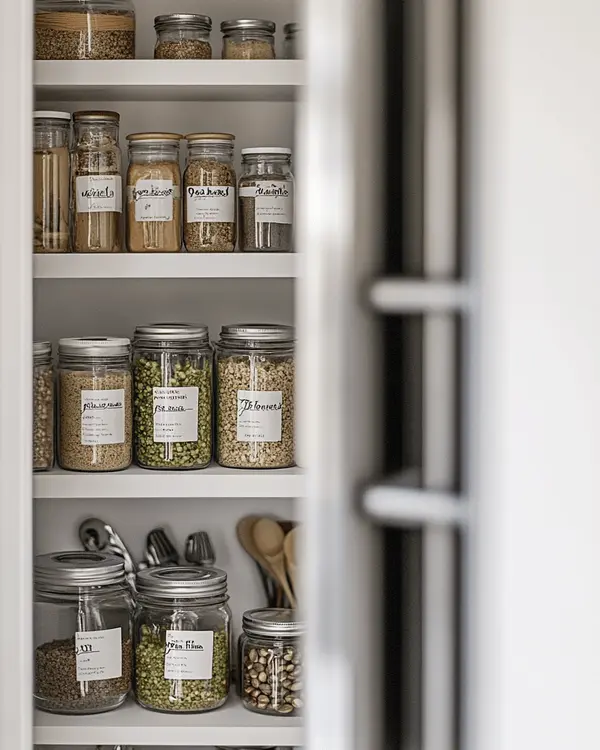
Nutritional Profiles
Pistachio butter provides concentrated nutrition from pistachios alone. This means higher protein content, healthy fats, and essential minerals like potassium and magnesium. A typical serving contains approximately 190 calories, 6 grams of protein, and 15 grams of healthy fats.
Pistachio cream, with its added ingredients, offers a different nutritional profile. The sugar content increases the calorie count while diluting the protein concentration. However, it may provide easier digestibility for some people due to its smoother texture.
Dietary Considerations
For those following specific dietary plans, pistachio butter offers advantages. It’s naturally vegan, keto-friendly, and paleo-compliant. Many people with nut allergies (other than pistachios) can safely enjoy pure pistachio butter.
Pistachio cream may contain dairy or other allergens depending on the brand. Always check labels carefully if you have dietary restrictions or food allergies.
Making Your Own: DIY Options
Homemade Pistachio Butter
Creating your own pistachio butter requires just one ingredient: high-quality roasted pistachios. Start with 2 pounds of shelled pistachios for best results—smaller quantities don’t process as well.
Process the pistachios in a food processor for 2-3 minutes until they form coarse crumbs. Scrape down the sides, then continue processing for another 5-8 minutes. The mixture will form a ball, then gradually become creamy as the natural oils release.
The entire process takes 15-20 minutes of active processing time. Be patient—rushing will result in inferior texture. The final product will be slightly grainy compared to commercial versions, but the flavor will be incredibly fresh and vibrant.
DIY Pistachio Cream
Homemade pistachio cream allows complete control over sweetness and texture. Start with your homemade pistachio butter, then add powdered sugar (start with 2 tablespoons per cup), a pinch of salt, and neutral oil as needed for consistency.
Some bakers add a small amount of white chocolate or coconut milk for extra richness. Vanilla extract complements the pistachio flavor beautifully. Process everything together until smooth, adjusting ingredients to taste.
Expert Tips from Professional Bakers
Temperature Matters
Both spreads perform differently at various temperatures. Room temperature pistachio cream incorporates more easily into batters and frostings. Cold pistachio butter needs gentle warming to become workable.
Flavor Pairing Secrets
Pistachio butter pairs exceptionally well with rose water, orange zest, and dark chocolate. These combinations create sophisticated flavor profiles that elevate simple desserts.
Pistachio cream works beautifully with vanilla, almond extract, and fresh berries. The sweeter profile complements delicate flavors without overwhelming them.
Professional Applications
Many high-end restaurants use pistachio cream in plated desserts because of its elegant appearance and smooth texture. However, they often choose pistachio butter for ice cream bases where intense flavor is crucial.
Frequently Asked Questions
Is pistachio butter the same as pistachio cream in baking?
No, pistachio butter and pistachio cream behave differently in baking applications. Pistachio butter provides intense flavor and can affect moisture content due to its natural oils. Pistachio cream offers milder flavor and smoother incorporation but may add extra sweetness to your recipes. When substituting one for the other, adjust other liquid and sugar ingredients accordingly.
Can I substitute pistachio cream for pistachio butter in recipes?
You can substitute pistachio cream for pistachio butter, but expect flavor and texture differences. Reduce added sugars in your recipe since pistachio cream is pre-sweetened. You may need to add extra nuts or nut flour to achieve the same intensity of pistachio flavor. The final product will be smoother but potentially less flavorful.
Which pistachio spread works better for homemade ice cream?
Pistachio butter creates more intensely flavored ice cream with authentic nutty taste. However, it may create a slightly grainier texture. Pistachio cream produces smoother ice cream but with milder flavor. Many professional ice cream makers combine both—using pistachio butter for flavor base and pistachio cream for texture enhancement.
How can I tell if my pistachio spread has gone bad?
Fresh pistachio spreads smell pleasantly nutty and maintain their green color. Spoiled products develop rancid odors, off-flavors, or unusual color changes. Pistachio butter may separate naturally (just stir it), but any fuzzy growth indicates spoilage. Trust your senses—if it smells or tastes off, discard it immediately.
The Bottom Line: Choosing Your Perfect Pistachio Spread
After years of experimenting with both spreads in my kitchen, I’ve learned that the choice between pistachio butter and pistachio cream depends entirely on your intended use. Neither is inherently better—they’re simply different tools for different culinary purposes.
Choose pistachio butter when you want pure, intense pistachio flavor and don’t mind a slightly rustic texture. It’s perfect for serious bakers who want control over sweetness levels and appreciate authentic taste.
Opt for pistachio cream when smooth texture and elegant presentation matter most. It’s ideal for quick desserts, gift-giving, or when serving guests who prefer milder flavors.
Why not keep both in your pantry? I do! Having both options available means never having to compromise on your dessert vision. Whether you’re creating rustic homemade cookies or elegant dinner party desserts, you’ll always have the right pistachio spread for the job.
Remember that magical moment I shared about my neighbor’s confusion? Well, she ended up buying both jars and never looked back. Sometimes the best answer isn’t choosing one or the other—it’s embracing the delicious possibilities that both can offer.
What’s your favorite way to use pistachio spreads? I’d love to hear about your experiments and discoveries. After all, the best recipes come from fellow passionate bakers sharing their kitchen adventures!

